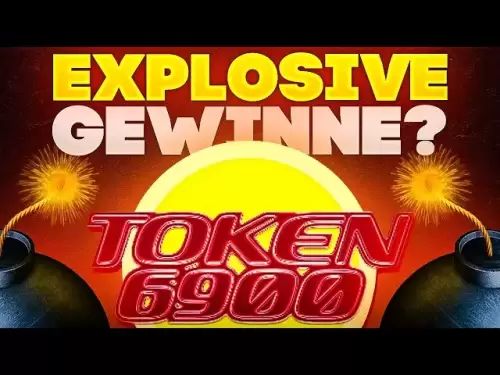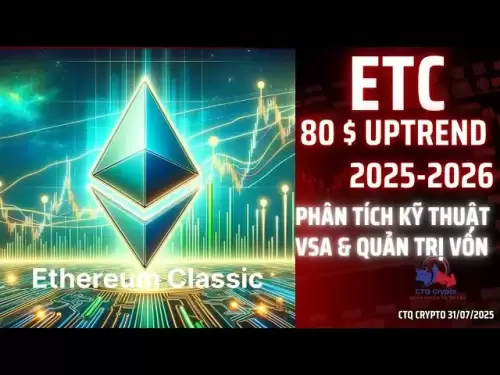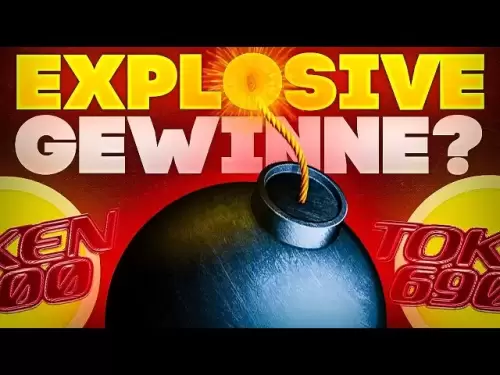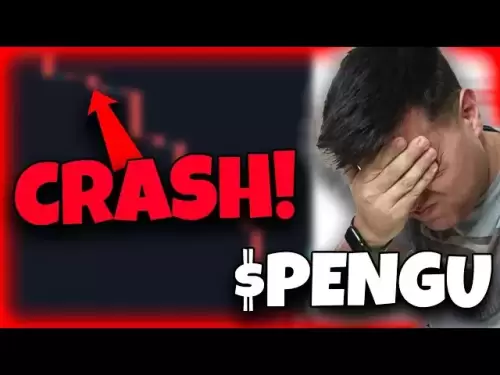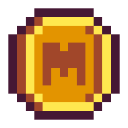-
 Bitcoin
Bitcoin $118400
0.47% -
 Ethereum
Ethereum $3836
2.20% -
 XRP
XRP $3.157
2.98% -
 Tether USDt
Tether USDt $0.9999
-0.03% -
 BNB
BNB $801.5
1.31% -
 Solana
Solana $180.9
2.07% -
 USDC
USDC $0.9999
-0.02% -
 Dogecoin
Dogecoin $0.2225
2.50% -
 TRON
TRON $0.3285
-1.02% -
 Cardano
Cardano $0.7789
2.60% -
 Hyperliquid
Hyperliquid $43.60
2.39% -
 Sui
Sui $3.892
4.41% -
 Stellar
Stellar $0.4229
3.34% -
 Chainlink
Chainlink $18.01
3.98% -
 Hedera
Hedera $0.2745
6.77% -
 Bitcoin Cash
Bitcoin Cash $582.3
3.38% -
 Avalanche
Avalanche $23.77
1.04% -
 Ethena USDe
Ethena USDe $1.001
0.01% -
 Toncoin
Toncoin $3.493
3.59% -
 Litecoin
Litecoin $110.0
2.48% -
 UNUS SED LEO
UNUS SED LEO $8.936
-0.37% -
 Shiba Inu
Shiba Inu $0.00001304
2.49% -
 Uniswap
Uniswap $9.999
1.09% -
 Polkadot
Polkadot $3.897
3.26% -
 Monero
Monero $308.6
-0.83% -
 Dai
Dai $0.9999
-0.01% -
 Bitget Token
Bitget Token $4.504
-0.04% -
 Pepe
Pepe $0.00001154
2.95% -
 Cronos
Cronos $0.1471
3.06% -
 Ethena
Ethena $0.6691
19.53%
How do users in the NFT secondary market verify the authenticity of artworks?
Users can verify NFT authenticity using blockchain explorers, smart contract checks, marketplace tools, community insights, and third-party verification services.
Apr 19, 2025 at 02:21 am
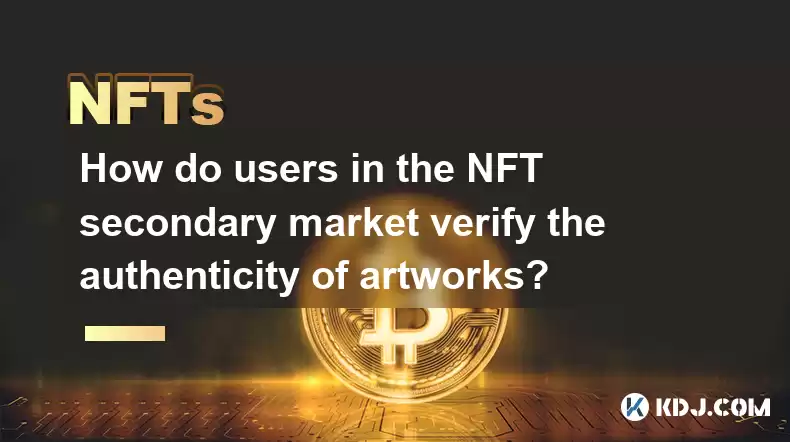
In the world of NFTs (Non-Fungible Tokens), the secondary market has become a bustling hub for trading digital art and collectibles. With the rise of this market, the question of authenticity has become increasingly important. How do users in the NFT secondary market verify the authenticity of artworks? This article delves into the various methods and tools that users can employ to ensure they are purchasing genuine pieces.
Understanding NFT Authenticity
Before diving into the verification methods, it's crucial to understand what makes an NFT authentic. An NFT's authenticity is tied to its unique digital signature and the blockchain on which it is minted. Each NFT has a distinct token ID and is linked to a specific wallet address, making it verifiable and immutable. The authenticity of an NFT is primarily determined by its provenance, which can be traced back to the original creator and the blockchain transaction history.
Using Blockchain Explorers
One of the most straightforward ways to verify the authenticity of an NFT is by using blockchain explorers. These tools allow users to view the entire transaction history of an NFT, from its initial minting to its current ownership. Here's how you can use a blockchain explorer to verify an NFT:
- Select a blockchain explorer: Popular choices include Etherscan for Ethereum-based NFTs and Solscan for Solana-based NFTs.
- Enter the NFT's contract address: This can usually be found on the NFT's listing page on marketplaces like OpenSea or Rarible.
- Locate the token ID: The token ID is a unique identifier for the NFT, which can also be found on the listing page.
- Review the transaction history: Look for the initial minting transaction and subsequent transfers to ensure the NFT's provenance is legitimate.
By examining the transaction history, users can confirm that the NFT has not been tampered with and that its ownership trail is intact.
Checking Smart Contract Details
Another method to verify the authenticity of an NFT involves checking the smart contract details. Smart contracts are self-executing contracts with the terms of the agreement directly written into code. They are responsible for managing the creation, ownership, and transfer of NFTs. Here's how to check the smart contract details:
- Access the smart contract address: This is usually provided on the NFT's listing page.
- Use a smart contract auditing tool: Tools like Etherscan's Contract Inspector or third-party platforms like OpenZeppelin can provide insights into the smart contract's code.
- Verify the contract's functionality: Ensure that the smart contract is designed to handle NFTs correctly and that there are no vulnerabilities or suspicious activities.
By verifying the smart contract, users can gain confidence in the NFT's authenticity and the integrity of its management.
Utilizing NFT Marketplaces' Verification Tools
Many NFT marketplaces, such as OpenSea and Rarible, have built-in verification tools to help users authenticate artworks. These tools often include features like verified creator badges and authenticity checks. Here's how to use these tools:
- Check for verified creator badges: These badges indicate that the marketplace has confirmed the identity of the creator.
- Use the marketplace's authenticity check: Some platforms offer an authenticity check feature that verifies the NFT's origin and ownership history.
- Review the NFT's listing details: Look for any additional information provided by the seller, such as provenance certificates or artist statements.
By leveraging these marketplace tools, users can more easily verify the authenticity of NFTs listed for sale.
Engaging with NFT Communities
The NFT community is a valuable resource for verifying the authenticity of artworks. Engaging with other collectors, artists, and enthusiasts can provide additional layers of verification. Here's how to engage with the NFT community:
- Join NFT-focused forums and social media groups: Platforms like Discord, Reddit, and Twitter have active NFT communities where users can ask for advice and share information.
- Consult with experienced collectors: Reach out to seasoned collectors who may have insights into the authenticity of specific NFTs or artists.
- Participate in artist AMAs (Ask Me Anything) sessions: Many artists host AMAs where they discuss their work and can confirm the authenticity of their NFTs.
By tapping into the collective knowledge of the NFT community, users can gain a deeper understanding of an NFT's authenticity.
Using Third-Party Verification Services
In addition to the methods mentioned above, users can also turn to third-party verification services that specialize in authenticating NFTs. These services often employ advanced technologies and have extensive databases to verify the provenance and authenticity of digital artworks. Here's how to use third-party verification services:
- Research reputable services: Look for well-established companies with a track record of successful NFT verifications.
- Submit the NFT for verification: Follow the service's process for submitting the NFT, which may include providing the token ID and contract address.
- Review the verification report: Once the service has completed its analysis, review the report to confirm the NFT's authenticity.
By utilizing third-party verification services, users can add an extra layer of assurance to their NFT purchases.
Frequently Asked Questions
Q: Can the authenticity of an NFT change over time?
A: The authenticity of an NFT itself does not change over time, as it is tied to the blockchain and its immutable transaction history. However, the perceived value or legitimacy of an NFT can be affected by external factors, such as changes in the reputation of the creator or the discovery of previously unknown issues with the smart contract.
Q: Are there any risks associated with relying solely on marketplace verification tools?
A: While marketplace verification tools are useful, they are not infallible. There is a risk that these tools may miss certain issues or be manipulated by malicious actors. It's important to use multiple verification methods to ensure the authenticity of an NFT.
Q: How can I protect myself from buying counterfeit NFTs?
A: To protect yourself from buying counterfeit NFTs, always use a combination of verification methods, such as blockchain explorers, smart contract checks, marketplace tools, community insights, and third-party verification services. Additionally, be cautious of deals that seem too good to be true and always research the seller and the NFT's provenance thoroughly.
Q: Is it possible to verify the authenticity of an NFT without technical knowledge?
A: While some technical knowledge can be helpful, it is possible to verify the authenticity of an NFT without being an expert. Many tools and services are designed to be user-friendly, and the NFT community is often willing to help guide newcomers through the verification process.
Disclaimer:info@kdj.com
The information provided is not trading advice. kdj.com does not assume any responsibility for any investments made based on the information provided in this article. Cryptocurrencies are highly volatile and it is highly recommended that you invest with caution after thorough research!
If you believe that the content used on this website infringes your copyright, please contact us immediately (info@kdj.com) and we will delete it promptly.
- SEC, Crypto, and Securities: Navigating the New Frontier
- 2025-08-01 05:10:12
- Cardano (ADA) Market Cap: Can It Compete with Emerging Cryptocurrencies and Meme Coins?
- 2025-08-01 04:30:12
- SEC, Crypto, and On-Chain: Navigating the Regulatory Maze
- 2025-08-01 02:31:40
- Jito Labs, Solana, and Liquid Staking: Riding the Wave of Innovation
- 2025-08-01 03:50:12
- Perpetual DEX: Navigating Onchain Trading and Solving Core Problems, a NY Perspective
- 2025-08-01 03:57:53
- Bitcoin Bullish Market: How Long Positions are Boosting the Crypto King
- 2025-08-01 02:35:33
Related knowledge

Is it possible to get a refund on an NFT?
Jul 21,2025 at 08:35pm
Understanding NFT Transactions and RefundsWhen you purchase an NFT (Non-Fungible Token), the transaction is typically recorded on a blockchain, making...

What happens to NFTs when the owner dies?
Jul 22,2025 at 02:43pm
Legal Ownership and Digital AssetsWhen an individual owns NFTs, the question of what happens to these assets upon their death is a pressing one. NFTs ...

What are the tax implications of gifting an NFT?
Jul 19,2025 at 04:21am
Understanding the Basics of NFT GiftingGifting a Non-Fungible Token (NFT) involves transferring ownership from one individual to another without recei...

Can you trade NFTs on your phone?
Jul 18,2025 at 04:29am
Trading NFTs on Mobile DevicesYes, you can trade NFTs on your phone, and the process has become increasingly streamlined thanks to a variety of mobile...

How to find out about upcoming NFT mints?
Jul 18,2025 at 11:50am
Exploring NFT Minting OpportunitiesUnderstanding the landscape of upcoming NFT mints is crucial for collectors, investors, and creators who wish to st...

What is an allowlist or whitelist for an NFT mint?
Jul 20,2025 at 07:14pm
Understanding the Concept of an Allowlist for NFT MintingAn allowlist, also commonly referred to as a whitelist, is a mechanism used in the NFT mintin...

Is it possible to get a refund on an NFT?
Jul 21,2025 at 08:35pm
Understanding NFT Transactions and RefundsWhen you purchase an NFT (Non-Fungible Token), the transaction is typically recorded on a blockchain, making...

What happens to NFTs when the owner dies?
Jul 22,2025 at 02:43pm
Legal Ownership and Digital AssetsWhen an individual owns NFTs, the question of what happens to these assets upon their death is a pressing one. NFTs ...

What are the tax implications of gifting an NFT?
Jul 19,2025 at 04:21am
Understanding the Basics of NFT GiftingGifting a Non-Fungible Token (NFT) involves transferring ownership from one individual to another without recei...

Can you trade NFTs on your phone?
Jul 18,2025 at 04:29am
Trading NFTs on Mobile DevicesYes, you can trade NFTs on your phone, and the process has become increasingly streamlined thanks to a variety of mobile...

How to find out about upcoming NFT mints?
Jul 18,2025 at 11:50am
Exploring NFT Minting OpportunitiesUnderstanding the landscape of upcoming NFT mints is crucial for collectors, investors, and creators who wish to st...

What is an allowlist or whitelist for an NFT mint?
Jul 20,2025 at 07:14pm
Understanding the Concept of an Allowlist for NFT MintingAn allowlist, also commonly referred to as a whitelist, is a mechanism used in the NFT mintin...
See all articles























